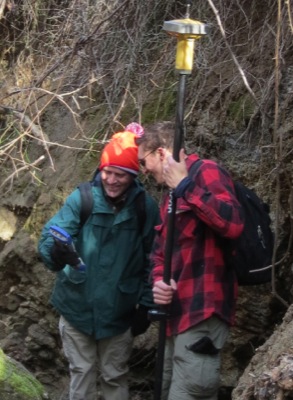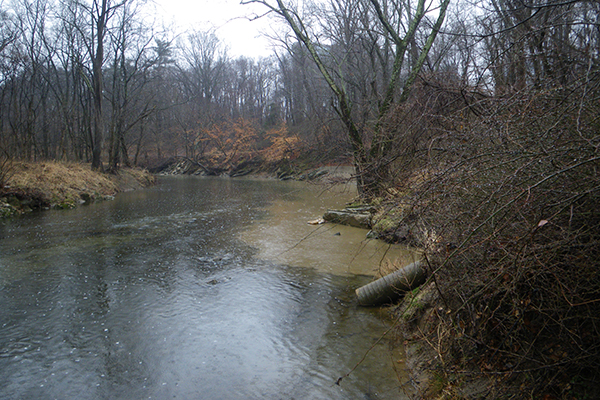Green infrastructure
UD students, faculty and staff aim to improve stormwater runoff
9:51 a.m., April 2, 2013--In a hydrology class last fall, University of Delaware students saw firsthand the lasting impact of storm runoff: deep gullies carved into the ground by rainfall over several decades. These gullies start at drainpipes that open into the woods near Laird Campus, and during storms they collect water and flush sediment into White Clay Creek.
Luc Claessens, assistant professor of geography in the College of Earth, Ocean, and Environment who studies human effects on watersheds, used the field trip to connect classroom material with real-world experiences. Now he is working with UD staff and students to develop a comprehensive plan that would improve stormwater drainage at the site, supported by a UD Sustainability Fund grant.
Campus Stories
From graduates, faculty
Doctoral hooding
“What we’ll do is come up with a design for green infrastructure for this part of campus,” Claessens said. “It is a unique setting for all participants to learn about the challenges and opportunities of reducing environmental impacts.”
Nature’s stormwater management system is to absorb rain into the ground, but roads, parking lots and other hard surfaces cover up this environmental sponge. Construction is currently regulated by the state to reduce flow and pollutants, although prior to 1990, common practice was to direct runoff into wooded areas — which is what largely caused the gullies near Laird Campus.
During rainstorms, the sediment-laden runoff sweeps right under the scenic Pomeroy Trail and creates mocha-colored plumes of sediment into the White Clay Creek, which is a National Wild and Scenic River. Claessens collected water samples during Hurricane Sandy that showed high levels of sediment, which can pose problems for aquatic life and make drinking water taken from the creek more expensive to clean.
Claessens is collaborating with Gerald Kauffman, director of UD’s Water Resources Agency, to create hydrologic and hydraulic engineering designs for the project. Other UD resources include Environmental Health and Safety and Facilities for assistance with outreach and landscape aspects.
Several students are also involved. Last fall Claessens advised a UD student team entry for the EPA Campus RainWorks Challenge to design a preliminary green infrastructure plan for the Christiana Towers area. The interdisciplinary team included graduate students in geography (Asia Dowtin), water science and policy (Matt Bachman and Kate Miller) and energy and environmental policy (Craig Dsouza).
This spring Claessens and Kauffman are advising an interdisciplinary team of five UD-WATER undergraduate interns on this project, including majors in environmental science (Megan Mauger), environmental studies (Devika Banerjee), environmental engineering (Kate Aulenbach and Virginia Thornton) and biological sciences (Megan Shaffer). The interns are funded by the Delaware Water Resources Center, which is directed by Tom Sims in the College of Agriculture and Natural Resources. A recent addition to the team is Alex Soroka, an incoming graduate student in water science and policy who works with Claessens.
“As an environmental studies major, I am seeking a way to interact more with this field of study,” said Banerjee. “I feel as though it is imperative to gain firsthand experience to better determine my future plans.”
Apart from designing green infrastructure, the team will be mapping gullies, characterizing the watershed and organizing outreach activities. The team will also design a future stormwater interpretive trail to explain stormwater issues and green solutions, complementing similar signs that are already in place on Laird Campus about native vegetation and rain gardens. The project will include cost estimates, funding opportunities and water quality monitoring.
Solutions the team will explore are constructed wetlands that hold water and then gradually drain into the ground. Another option is putting in rain gardens to help absorb water and make the area more attractive. They could also recommend installing infiltration strips in the parking lots to prevent water from entering storm drains.
“The idea is that you want to infiltrate as much water as possible, and not have it go into the creek,” Claessens said.
About a year from now, amended state regulations might provide incentives to put into use green stormwater practices like green roofs, stormwater wetlands and porous paving. Some of these measures are already in place elsewhere on UD’s campus.
“There are always opportunities to retrofit to protect our drinking water supply,” Kauffman said.
The project dovetails into Claessens’ broader research. One of his other projects is to examine legacies in urban stormwater management in the larger Piedmont region of the Christina River Basin; that project is partially funded by a UD General Research Fund grant. Claessens and his team will use geographic information systems (GIS) and field measurements to map where stormwater hotspots are, and then target those areas for better management. He is also analyzing his Hurricane Sandy and other storm samples for total suspended solids, both at the top and bottom of the gullies, before and after the hurricane.
“During Sandy, some of them were delivering a lot of sediment into the creeks and some of them were not,” Claessens said. “So now we’re doing research into that.”
Article by Teresa Messmore
Photos courtesy of Luc Claessens












